The Importance of Board Leashes in Kiteboarding Safety

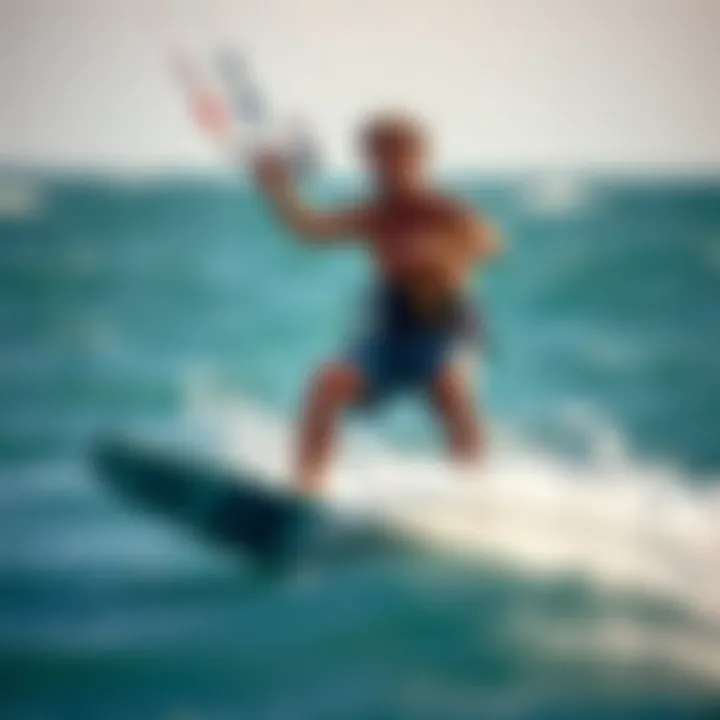
Intro
Kiteboarding is not for the faint of heart. It’s a thrilling blend of surfing, paragliding, and aspects of skateboarding that requires skill, determination, and the right gear. Among the sea of equipment available, few items are as essential as the board leash. While many beginners might overlook its importance, the board leash can significantly enhance safety and overall experience on the water. This introductory section aims to establish the significance of the board leash, paving the way for a deeper exploration of its design, functionality, types, and best practices for both novices and experienced riders alike.
Understanding the Board Leash
At its core, a board leash is a safety device that attaches the surfer to their board. This key piece of equipment avoids the nightmare scenario of losing your board in the water. Just as a life jacket keeps you afloat, a good board leash ensures that your board stays close, preventing it from drifting away after a wipeout.
The concept may seem straightforward, but there are nuances in design and materials that cater to different surfing styles and conditions. Throughout this article, we will dissect these elements, giving kiteboarding enthusiasts a comprehensive understanding to up their game on the waves.
Relationship to Safety and Performance
Safety in kiteboarding cannot be overstated. When the wind howls and the sea churns, having a reliable leash becomes your safety net. It’s not just about protecting your gear, but also about ensuring your own well-being. Without a leash, a runaway board could pose a danger to fellow riders.
Moreover, a proper leash can improve performance. It allows riders to concentrate on their technique rather than worrying about retrieving their board after a fall. The following sections will elaborate on the various types of leashes, their advantages and disadvantages, and expert recommendations that gear enthusiasts should consider before hitting the water.
Understanding the Board Leash
In the dynamic world of kiteboarding, understanding the board leash is not just a matter of preference but a necessity for safety and performance. A board leash is more than just an accessory; it serves as a critical link between the kiteboard and rider. Without it, the risk of losing control during a session multiplies, leading to potentially dangerous situations, especially in unpredictable water conditions.
Having a grasp on the intricacies of the board leash informs kiteboarders of its multifaceted roles—ranging from ensuring safety to enhancing equipment return efficacy. Riders who overlook its importance might find themselves scrambling to retrieve a board that drifts away after a wipeout, or worse, putting themselves in harm's way without an essential safety tether.
Definition and Purpose
A board leash is defined as a cord that ties the rider to their board, which helps in preventing the board from floating away in case of falls. Its primary purpose is to enable quick recovery of the board after a fall, allowing riders to maintain control and safety during their session. It keeps the board within reach, reducing the time taken to get back on track.
The leash is designed to stretch, ensuring comfort while still being sturdy enough to endure the tugging and pulling forces experienced during riding. This almost elastic quality allows for a bit of movement, which can keep the rider from feeling too restrained. The board leash is typically attached to the rider's ankle or calf, depending on personal preference.
Historical Background
The history of the board leash traces back to the early days of surfing. As the sport evolved, so did the equipment, including leashes, which emerged as a solution to a problem experienced by surfers — losing their boards after a fall. The concept was borrowed and expanded upon in the kiteboarding community. In the late 1980s and early 1990s, as kiteboarding began to gain popularity, the need for a more specialized leash became evident. Riders were often finding themselves in challenging situations, with their boards drifting away in strong winds.
This necessity led to the development of tailored designs for kiteboarding. The materials used in leashes transitioned from basic ropes to specialized, weather-resistant materials that provide durability and resistance against wear and tear from saltwater and sun exposure.
In a nutshell, understanding the board leash's evolution and its purpose in kiteboarding illustrates why it is indispensable in modern-day kiteboarding. It not only provides safety but also enables riders to focus on enjoying the ride, knowing their gear is attached and within reach.
The Anatomy of a Board Leash
Understanding the anatomy of a board leash is crucial to grasping its role in kiteboarding safety. A well-designed board leash not only keeps your board within reach but also plays an essential part in preventing injuries and ensuring an enjoyable ride. Delving into the materials and components that make up a board leash sheds light on its function and effectiveness.
This section takes a closer look at two vital aspects of board leashes: the materials used and the components that are involved. Each section provides insight into how these elements contribute to overall performance and safety on the water.
Materials Used
Board leashes are crafted from various materials, each with its own set of characteristics that affect durability and performance. The primary materials used in the construction of a board leash include:
- Neoprene: This material is often used for the cuff or ankle attachment. Its flexible nature allows it to conform comfortably to the rider's body.
- Nylon: The leash cord itself is typically made of nylon which balances strength and weight. Nylon is resistant to the wear and tear of saltwater and sun, making it a logical choice for kiteboarding.
- Polyester: Sometimes used as an alternative to nylon, polyester may be employed due to its high resistance to UV rays and reduced stretch, which can be beneficial in certain riding conditions.
- Bungee Material: Some leashes incorporate bungee sections to provide shock absorption and decrease the chance of sudden pulls on the rider, reducing the risk of injury.
Each of these materials serves a specific purpose in enhancing the performance and safety of the board leash. For instance, using a combination of these materials can lead to leashes that are both lightweight and robust, striking a balance that is vital for kiteboarders who demand reliability in a variety of conditions.
Components Explained
A board leash features several key components that enhance its functionality. Understanding these parts can help riders choose the right leash for their needs.
- Cuff: The cuff is the part that connects the leash to the rider, often adjustable and padded for comfort. An ill-fitting cuff can lead to discomfort and distractions while riding, possibly impacting performance.
- Leash Cord: This is the main component that connects the board to the rider. The length and thickness of the leash cord can influence handling and control. Longer leashes provide freedom of movement, but might lead to more tangles, while shorter leashes offer more control but less room to maneuver.
- Swivel: Often located near the cuff or the board connection, the swivel helps to prevent tangles in the leash cord. A tangle-free experience is important, as tangled leashes can hinder performance and cause accidents.
- Board Attachment: The mechanism that attaches the leash to the board varies among different models. Some employ Velcro straps while others might use a clip or ring that ensures a snug fit.
By recognizing how these components interact, kiteboarders can make informed decisions about their board leashes, enhancing their overall kiteboarding experience.
"A well-crafted board leash should feel like an extension of yourself—not a hindrance while you soar over the waves."
Types of Board Leashes
When it comes to kiteboarding, the choice of board leash is an important decision that affects both safety and performance on the water. Understanding the various types of board leashes can guide riders in selecting the right one for their needs, leading to a more enjoyable and safer experience riding the waves. Let's break down the different types.
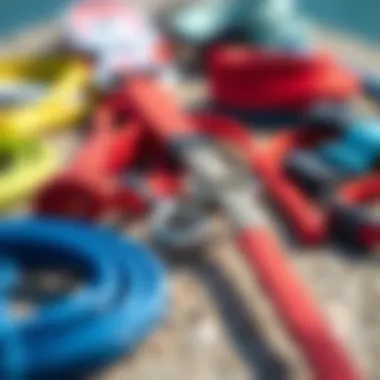
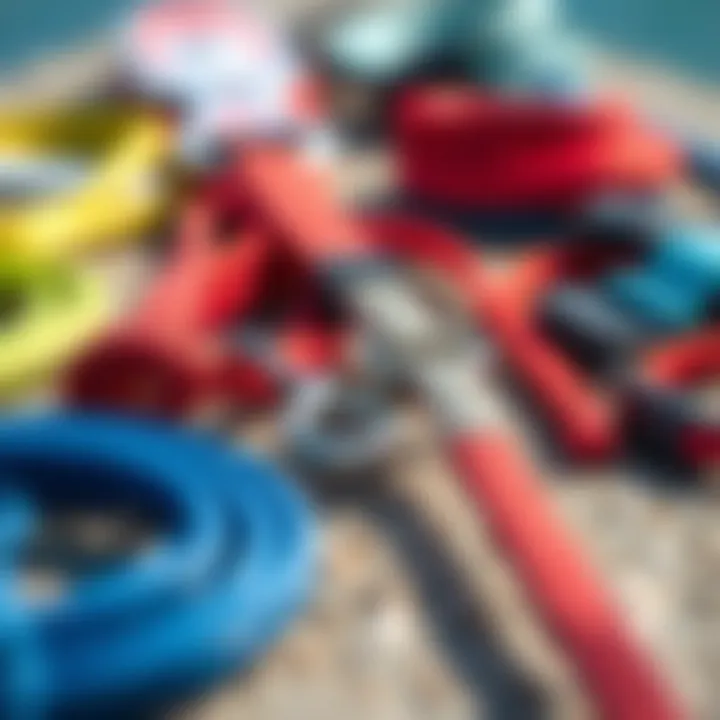
Coiled vs. Straight Leashes
Coiled leashes, as the name suggests, are designed in a spiral coil form, allowing them to stretch and retract when necessary. These leashes are favored for their ability to remain out of the way while riding, reducing the risk of entanglement. Riders who often perform jumps or tricks find coiled leashes particularly useful, as they minimize drag when not in use. On the flip side, straight leashes provide a more direct line to your board, which can make them easier to manage in certain conditions.
Both designs have their merits, so it's crucial for kiteboarders to assess their own riding style and environmental conditions to choose the best fit.
Adjustable Length Options
An adjustable leash length can be a game changer for kiteboarders, offering flexibility based on wind conditions or riding location. For those engaging in varied activities, an adjustable leash means you won't be stuck with a one-size-fits-all solution.
Having the ability to extend or retract ensures that riders can tailor the leash length to their skill level and the challenges they face. A longer leash can be beneficial for freeriding, giving the rider more room to maneuver, while a shorter leash may enhance control during technical runs or when conditions become choppy.
Specialized Designs
Wind-specific Leashes
Wind-specific leashes are engineered with precise conditions in mind, catering to kiteboarders who frequent areas with predictable wind patterns. One key characteristic of these leashes is their ability to provide a quick release mechanism in high winds. This feature allows riders to detach from their board swiftly in difficult situations, enhancing safety significantly. As a result, these leashes are extremely popular among seasoned kiteboarders who seek reliable performance in challenging environments.
A standout aspect of wind-specific leashes is their durability, often crafted from robust materials that can withstand the elements. This added strength is pivotal, as kiteboarding in strong winds can lead to extra wear and tear. Although these leashes tend to be on the pricier side, the assurance they provide makes them a worthy investment for serious enthusiasts.
Performance-oriented Leashes
Looking for a leash that excels in performance? Performance-oriented leashes focus on the demands of advanced riders. Featuring lightweight materials and streamlined designs, these leashes prioritize responsiveness and minimal drag, allowing for maximum agility on the water. This makes them the go-to choice for competitive kiteboarders who need to fine-tune every aspect of their ride.
One unique feature of performance-oriented leashes is their shock absorption capability, which helps to lessen the impact during intense maneuvers or when riding on choppy waters. While they shine in providing superior performance, these leashes may not be as durable as their wind-specific counterparts, necessitating regular inspections and maintenance to ensure reliability.
In summary, the variety of board leashes offers something for everyone, but choosing the right type hinges on understanding specific needs. Whether opting for the versatility of a coiled leash, the adaptability of adjustable lengths, or the specialization of wind and performance-oriented designs, each choice carries implications for safety and performance that should be carefully weighed.
Benefits of Using a Board Leash
When it comes to kiteboarding, the importance of a board leash cannot be overstated. This seemingly simple piece of gear plays a crucial role in ensuring the safety and overall experience of riders on the water. Each kiteboarder, whether a novice or a seasoned pro, should understand these benefits to appreciate the value of integrating a board leash into their routine. Let’s unpack the advantages in detail.
Enhanced Safety
First and foremost, using a board leash significantly boosts safety. Imagine cruising along the waves, when suddenly you tumble off your board. Without a leash, that board can become a dangerous projectile, posing risks to you and others around you. The leash keeps the board tethered, preventing it from floating away, which is not only a hazard but also means you won’t have to swim long distances to retrieve it. This kind of safety net can be the difference between a minor mishap and a potentially serious accident.
Furthermore, a board leash acts as a point of connection. In windy conditions, having that link reduces the chance of the board inadvertently drifting away and being caught in the power zone of your kite. It’s about maintaining control, ensuring that your equipment works for you, thus making each session less stressful and much safer.
Improved Equipment Recovery
Another essential benefit of using a board leash is the ease of equipment recovery. If you take a spill, your board is right where you left it, attached to your ankle or waist. This prevents the need to chase after your gear, saving both energy and time. In environments where tides can pull equipment away, this security becomes even more critical. In shallow waters or crowded beaches, it can be particularly chaotic when riders attempt to retrieve runaway boards. A leash removes the uncertainty from this situation, letting you concentrate on enjoying your ride.
Not to mention, if you’ve invested in high-quality gear, capturing it swiftly ensures it stays in top shape. Constantly retrieving a floating board can lead to scratches, dings, or, worse, damage to that valuable piece of equipment. Keeping it close adds longevity to your gear, a win-win for any kiteboard enthusiast.
Convenience on the Water
Convenience is a pivotal consideration when discussing the board leash. It plays a multifaceted role that enhances the kiteboarding experience. For example, when you’re ready to take a break from riding, being attached to your board means you can navigate through the water without losing track of your equipment. You can transition seamlessly from riding waves to leisurely enjoying the view without worrying about where your board might end up.
Additionally, with innovations in leash design, they now tend to be more comfortable and minimalistic. Many riders dislike bulky or cumbersome setups that hinder their movement. Modern leashes offer solutions that are lightweight yet strong, allowing for mobility without sacrificing safety. More convenience means less trouble, and who wouldn’t prefer it that way?
In summary, the benefits of a board leash extend far beyond mere attachment. It brings safety, efficient recovery, and convenience into the mix, making it a crucial piece of gear for kiteboarders of all levels. No one wants to be in a sticky situation due to a lack of foresight—investing in a solid board leash could just be your best decision on the water.
Challenges and Considerations
When delving into the world of kiteboarding, safety cannot be overlooked, particularly when it comes to using a board leash. While many riders might focus on the thrill and excitement of riding the waves, it’s essential to address the challenges and considerations associated with this crucial piece of gear. Understanding these elements not only enhances safety but also optimizes performance for kiteboarders of all skill levels.
Cost vs. Quality
The financial aspect of purchasing kiteboarding gear often raises eyebrows, especially with board leashes available in a wide price range. However, when considering cost vs. quality, it’s important to realize that skimping on safety gear can have dire consequences. A lower-priced board leash may seem like a bargain until it fails at a critical moment on the water. Conversely, investing a bit more in a high-quality board leash crafted from durable materials can save a rider from accidents or even serious injury.
- Key factors to consider in cost vs. quality include:
- Material Durability: Cheaper leashes may be made from lower-quality materials that degrade faster.
- Construction Type: A well-constructed leash should resist tangles and not snap under duress.
- Manufacturer Reputation: Trusted brands often offer a warranty or guarantee, which adds value.
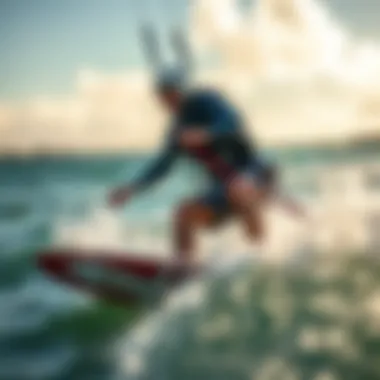
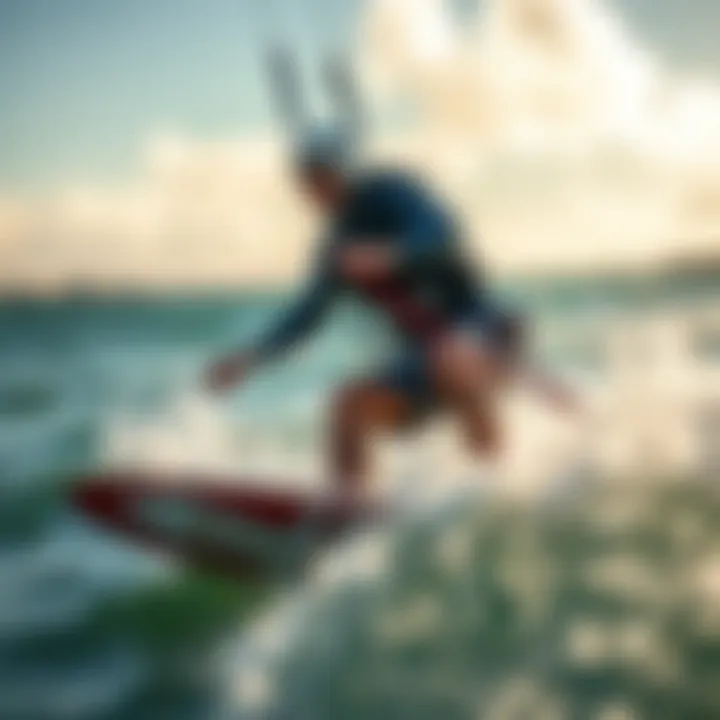
Ultimately, when it comes to kiteboarding, a reliable leash coupled with a firm understanding of its purpose justifies the added expense.
Potential Risks of Inadequate Use
Like any safety device, the potential risks associated with improper use of a board leash can be significant. Using a leash incorrectly can negate its very purpose, putting riders in risky situations.
For instance, if the leash is not properly attached to both the rider and board, there’s a high chance the board could drift away in strong winds or turbulent water. Not only does this create logistical hassles, but it also poses a risk to other water users who could inadvertently collide with a rogue board.
- Common risks linked with improper board leash usage can involve:
- Detachment: Equipment snapping loose under pressure due to faulty attachments.
- Entanglement: A poorly placed leash can wrap around a rider's limbs, leading to falls.
- Inadequate Length: A leash that's too long or too short can affect a rider's ability to maneuver efficiently.
It is crucial that every kiteboarder carefully assesses their leash setup before hitting the water. The right practices in securing and using a leash can mean the difference between a safe ride and a potential disaster.
These challenges and considerations should be front and center for anyone participating in the exciting sport of kiteboarding. They reflect not just a rider's commitment to safety but also a deeper understanding of their gear and its nuances. By taking time to confront these aspects, kiteboarders empower themselves with the knowledge to enjoy the sport to its fullest.
Choosing the Right Board Leash
Selecting the appropriate board leash is crucial for kiteboarders, whether you're just dipping your toes in the water or are a seasoned professional. This decision can significantly influence your safety, performance, and overall enjoyment while out on the waves. The right leash ensures your board doesn’t get away from you, especially in challenging conditions. Moreover, understanding the various factors that play into this choice can equip you with the knowledge to make an informed decision, tailored to your individual style and skill level.
Factors to Consider
When it comes to board leashes, several factors stand out. Below, we’ll delve into two key aspects: the rider's skill level and the kiteboarding style they adopt.
Rider Skill Level
The rider skill level is paramount when selecting a board leash. It’s simple; more experienced kiteboarders often prefer specific leash types that complement their high-performance techniques. For instance, if you're a beginner, a straightforward coiled leash might be beneficial, as it reduces drag and keeps your board close after a fall. This is a significant advantage for those still mastering the basics of kite control and balance.
- Beginners: A coiled leash minimizes the risk of snagging in the water and is usually lighter, making it easier to manage in turbulent conditions.
- Intermediate to Advanced Riders: A straight leash may be the go-to since it allows for greater maneuverability and control during tricks or faster speeds. The downside? The lack of elasticity can sometimes lead to a less forgiving experience, especially during abrupt stops or falls, drastically impacting recovery.
Kiteboarding Style
Next up is kiteboarding style. Your approach to the sport can dictate which leash is ideal for you. Freestyle riders, who often flip and spin, may need a leash designed for high performance to withstand the aggressive activity. On the other hand, those leaning towards freeride may find they need something more forgiving but still durable.
- Freestyle: A more robust leash with extra attachment points might be necessary, providing the flexibility to handle flips without breaking.
- Freeride or Wave Riding: A lighter, coiled leash can enhance speed and reduce tangles, allowing for a smoother ride. However, it’s worth noting that, in some cases, this might decrease recovery speed in stronger winds.
Top Brands and Models
When it comes to choosing the right board leash, certain brands have carved out strong reputations within the kiteboarding community. Here are a few noteworthy mentions that athletes often swear by:
- Slingshot: Known for their durable yet lightweight designs, ideal for all riding styles.
- Naish: Offers a range of leashes that cater to both beginners and experts, ensuring you find something for your skill level.
- Cabrinha: Frequently preferred by freestyle riders due to their robust construction and specialized features.
- Duotone: Their innovative designs often include smart tech integration for enhanced performance.
Ultimately, the choice of leash boils down to personal preference, one that aligns with your kiteboarding aspirations. Knowing what works best for riders at different levels and styles allows you to make a wise decision, setting the stage for safer and more enjoyable rides.
"A good board leash can be the difference between a thrilling ride and a costly detour. Choose wisely."
In the vast ocean of kiteboarding gear, your leash should be your trusted companion, enhancing, rather than hindering, your water adventures.
Maintenance and Care
Taking care of your board leash isn’t just a matter of keeping it looking good; it’s about ensuring that your safety gear performs its best when you need it most. A well-maintained leash can drastically increase its lifespan and efficacy. Kiteboarding is inherently adventurous, full of twists and turns, and your gear needs to mirror that robustness. This section delves into crucial maintenance routines that kiteboarders should adopt to make sure their board leashes are up to snuff, so you can ride the waves without a worry.
Cleaning Techniques
Keeping your board leash clean is paramount. Sand, salt, and grime can work their way into the materials, affecting the leash's flexibility and strength. Here’s how to maintain its cleanliness:
- Rinse After Use: After finishing your kiteboarding session, give your leash a good rinse with fresh water. Saltwater can really take a toll on the fabric and components.
- Mild Soap Solution: Use a gentle, non-toxic soap mixed with water. Soak a cloth or sponge in the solution and wipe down the leash. Avoid harsh chemicals, as they can degrade materials.
- Inspect Regularly: While cleaning, keep an eye out for any signs of wear or tear. Look for fraying at the ends or any stiff areas that might indicate damage.
- Dry Properly: Hang your leash in a shaded area to dry. Direct sunlight can cause materials to break down over time, so it’s best to avoid prolonged exposure to UV rays.
By following these cleaning techniques, you not only keep your leash looking good but also ensure that it functions properly.
Storage Recommendations
Where and how you store your board leash can significantly impact its durability. Proper storage prevents kinks, tangles, and material degradation. Here are some tips to optimize storage:


- Avoid Tight Coiling: When storing your leash, don’t coil it too tightly. This can lead to creasing and damage. Instead, loop it loosely or flat.
- Cool, Dry Space: Keep your leash in a cool, dry area away from direct sunlight. A surfboard bag or a specific storage container keeps things organized and protected from environmental factors.
- Separate from Other Gear: It’s wise to store your leash away from other rough gear that might cause abrasions or cuts. Consider using a dedicated pouch or pocket for it when you pack your equipment.
- Check Periodically: Make it a habit to check on your stored gear every now and then, ensuring everything is in good shape and that nothing unexpected has happened during storage.
By adhering to these storage recommendations, kiteboarders can rest assured that their board leashes are ready to perform when the wind beckons. Taking the time to care for your gear pays off in the long run.
Proper maintenance of your board leash is not just about performance; it’s about ensuring your safety on the water. Take care of your gear, and it will take care of you.
Trends in Board Leash Technology
As kiteboarding continues to grow in popularity, so too does the necessity for innovative safety gear. One of the less talked about yet crucial pieces of equipment is the board leash. Understanding current trends in board leash technology is essential for kiteboarders who prioritize both safety and performance. These advancements not only enhance the rider experience but also provide the means to operate more efficiently on the water.
Innovations in Materials
Modern board leashes are transforming greatly thanks to breakthroughs in materials science. Traditionally made from PVC or elastic cords, today’s leashes incorporate advanced composites and environmentally-friendly alternatives.
- Lightweight yet Durable Fibers: Many contemporary leashes utilize materials such as Dyneema or Spectra, which offer impressive strength-to-weight ratios. These fibers can withstand extreme conditions while remaining remarkably light, ensuring that they don’t hinder the rider’s performance.
- Sustainable Options: Amid growing concerns about environmental impact, manufacturers are exploring biodegradable materials and recycled plastics in leash production. This shift not only addresses sustainability but also attracts eco-conscious kiteboarders who wish to minimize their carbon footprint.
Smart Technology Integration
The advent of smart technology in sports gear has permeated kiteboarding as well, modifying how leashes function and interact with their environment.
- Real-time Monitoring Capacities: Some of the latest board leashes come equipped with sensors that track usage and environmental conditions. This real-time feedback can alert the riders to conditions such as overextension or wear. Such innovations can signal when a leash may need maintenance or replacement, allowing users to prevent potential catastrophic failures.
- GPS Integration: Certain models have also started to feature integrated GPS, enabling riders to track their movements on the water. This can be particularly beneficial for those looking to analyze their performance or for safety measures in case of emergencies. The added navigation aids could potentially help in avoiding hazards or ensuring that lost gear can be found and recovered with ease.
"As technology and materials continue to advance, kiteboarding safety gear like the board leash is becoming more reliable and efficient. It's crucial for every rider to stay abreast of these developments to ensure they are using the best tools available."
For more insights, you might explore Wikipedia or join discussions on platforms like Reddit related to kiteboarding.
Expert Insights and Recommendations
When it comes to kiteboarding safety, there’s no substitute for expertise. The section on expert insights and recommendations is crucial as it distills the years of experience and knowledge from seasoned professionals in the field. These insights not only reinforce the importance of proper gear, like the board leash, but also provide practical tips for maximizing safety and performance on the water.
Interviews with Professionals
To truly grasp the significance of the board leash, hearing directly from those who have spent countless hours mastering the sport is invaluable. In interviews with industry professionals, we find consensus on a few key themes regarding the board leash:
- Trust Your Gear: Many pros emphasize how a reliable leash offers peace of mind during flights, allowing kiteboarders to focus on technique and enjoyment. One professional kiteboarding instructor remarked, "If I’m not confident in my leash, I can’t focus on my riding. It's like driving a car without knowing the brakes will work."
- Adaptation to Conditions: Experts often stress the importance of selecting the right leash for varying conditions. For instance, a pro who rides in both choppy waters and calm bays suggests, "A coiled leash is perfect for flat water but can fail in surf. Know your environment and choose wisely."
- Safety First: Safety discussions circle back to the role of the leash in preventing injuries during mishaps. Pro riders advocate for regular checks of the leash for wear and tear, stating that neglect can lead to dangerous outcomes.
Competitive Insights
Competitive kiteboarding is a realm where strategy and skill meet. Insights from competitive kiteboarders underscore how crucial the board leash is during competitions:
- Equipment Reliability: In contests, equipment failure can cost points and potentially win or lose a heat. One competitor remarked, "I always inspect my gear thoroughly before every heat—especially my leash. I can’t afford a snag or break when I’m going for gold."
- Customization: Many competitive riders customize their board leashes to match their unique riding styles or needs. As noted by a champion, "I prefer a leash that has a quick release mechanism. It makes adjustments easy, allowing me to transition seamlessly between moves."
- Training Aspect: The leash isn't just for competing; it’s also crucial during practice runs. Several professionals suggested using the leash as a training tool, honing skills while becoming accustomed to its presence in various conditions.
In summary, the insights and recommendations from experts are indispensable for kiteboarders, informing them not only about gear selection but also about safe riding practices and strategies tailored to their environment. Integrating learnings from these voices can enhance both enjoyment and security while kiteboarding.
"A board leash is more than just safety gear; it’s the link between you and the ocean. Choose wisely, ride smartly."
To dive deeper into the expert discussions, visit these resources:
Wikipedia Kiteboarding
Reddit Kiteboarding Community
Facebook Kiteboarding Group
When you’re out on the water, remember: your gear is your lifeline. Make informed choices and respect the sport.
Epilogue: The Importance of Safety Gear in Kiteboarding
In the high-energy world of kiteboarding, safety gear isn't just a suggestion; it's a necessity. This article sheds light on why the board leash plays a crucial role in ensuring that riders can enjoy their time on the water while minimizing risks. Kiteboarding is an exhilarating sport, yet it comes with inherent dangers. By relying on essential gear such as the board leash, enthusiasts can mitigate those risks significantly. Safety gear, especially the board leash, stands at the intersection of performance and protection.
One of the most significant elements discussed in this guide is the impact of board leashes on safety. The leash acts as a lifeline, preventing the board from drifting away, which can lead to dangerous situations, especially in strong wind and waves. Key benefits include enhanced control during rides, reduced likelihood of injury, and the convenience of equipment recovery. The advantage of having your gear tethered cannot be overstated, as it ensures that you remain connected with your board even in challenging conditions.
Furthermore, the considerations surrounding the choice and maintenance of board leashes highlight their importance. Selecting the right type of board leash should take into account rider skill level and intended kiteboarding style. Maintaining your gear through cleaning and proper storage prolongs its lifespan and effectiveness. This diligence speaks volumes about a kiteboarder's commitment to safety. By opting for quality gear and staying informed about advancements in technology, riders can further enhance their safety setup.
Kiteboarding isn't a sport where one can afford to be careless. Therefore, understanding the essentials, like the role of a board leash, is vital for any participant in this thrilling activity. Making informed decisions regarding safety gear will not only protect the athlete but also help safeguard their fellow riders. With this in mind, remember—safety gear is not just an accessory; it's an integral part of the experience.
"In kiteboarding, as in life, it's better to be tethered to safety than to let your dreams drift away unchecked."
Recap of Key Points
- Safety Over Stunt: The primary function of the board leash is to reduce potential risks while out on the water.
- Types Matter: Depending on the conditions and style, choosing between coiled or straight leashes can influence overall performance and safety.
- Regular Maintenance: Keeping your board leash in prime condition ensures its reliability when you need it the most.
Final Thoughts on the Board Leash
To cap it all off, the board leash is more than just a piece of equipment; it's a vital aspect of kiteboarding safety that can influence the rider's overall experience. As kiteboarding continues to evolve with innovative designs and materials, staying updated on the latest in safety gear is crucial. Enthusiasts should approach their sporting endeavors with both excitement and caution, carefully considering their safety provisions. In a sport where the wind can shift in a heartbeat, being prepared with reliable gear might be the difference between a thrill-seeking adventure and a hazardous experience.



